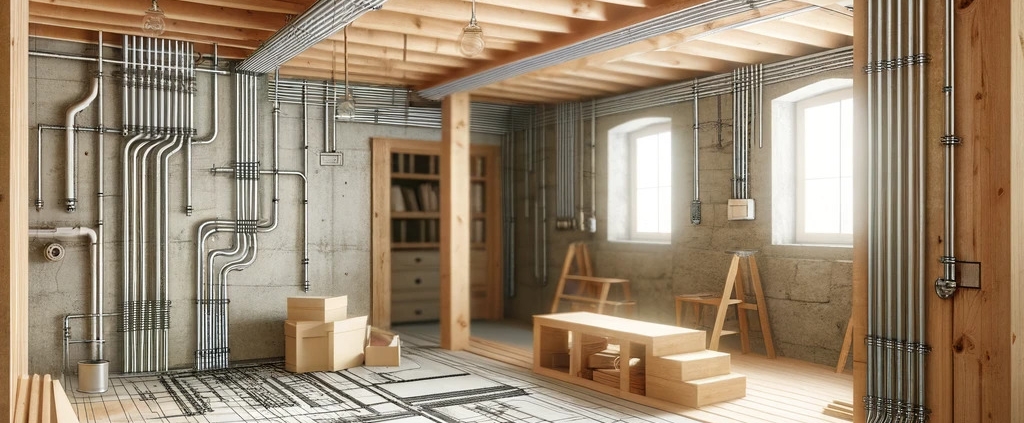Understanding Basement Renovations
Before you dive into the world of basement renovations, it’s essential to grasp what it entails and why you should consider it. This understanding can help you plan your project better, anticipate the potential basement renovation cost, and maximize the benefits.
What is a Basement Renovation?
A basement renovation is the process of transforming an underutilized or outdated basement into a functional, comfortable, and visually appealing space. It can range from minor changes like repainting and adding new furniture to comprehensive overhauls involving structural changes, electrical and plumbing updates, and installing new floors or walls.
This process is usually customized to your specific needs and preferences, and can serve various purposes. For instance, you might want to turn your basement into an extra bedroom, a home office, a playroom for your kids, or even a rental unit. The possibilities are virtually endless! To get a better idea of what you can do with your basement, have a look at our basement renovation ideas.
Why Renovate Your Basement?
There are several reasons to renovate your basement. First and foremost, it allows you to make full use of all the space in your home. Instead of having an empty or clutter-filled basement, you get an additional room that serves a specific purpose and enhances your home’s functionality.
Renovating your basement can also significantly increase the value of your property. A well-executed basement renovation can provide a high return on investment, making it a smart move if you plan to sell your home in the future.
Moreover, a renovated basement can offer additional comfort and enjoyment for you and your family. Whether it’s a cozy family room for movie nights, a personal gym for your workouts, or a quiet home office for your work, a renovated basement can significantly enhance your lifestyle.
Lastly, if designed with energy efficiency in mind, a renovated basement can help reduce your home’s energy consumption and lower your utility bills. This makes basement renovations not only an investment in your home, but also in your long-term savings.
With a clear understanding of what a basement renovation is and why it’s beneficial, you’re well-prepared to start planning your project. As you proceed, remember to keep in mind the factors that influence the overall basement renovation cost and to check out our guide on basement renovation steps to help you navigate the process.
Cost Factors in Basement Renovation
When it comes to estimating the cost of a basement renovation, several factors come into play. Let’s take a look at three of the most impactful: the size of the basement, its current condition, and the desired features and amenities. These elements can greatly influence the overall basement renovation cost.
Size of the Basement
Naturally, the larger your basement, the more it will cost to renovate. This is because a larger area requires more materials and more labor to complete the renovation. For instance, a 500 square-foot basement will obviously cost less to renovate than a 1,000 square-foot basement.
Here’s a simple table to help you understand how size can affect your basement renovation cost:
| Basement Size (sq. ft) | Average Renovation Cost |
|---|---|
| 500 | $10,000 – $15,000 |
| 1000 | $20,000 – $30,000 |
| 1500 | $30,000 – $45,000 |
Remember, these numbers are just averages and actual costs can vary based on other factors we will discuss below.
Current Condition of the Basement
Another important factor is the current condition of your basement. If your basement is unfinished, damp, or in need of major repairs, this will increase the cost. For example, if your basement has water damage, you’ll need to address this before starting any cosmetic renovations, which adds to the overall cost.
On the other hand, if your basement is already in good condition, with no major issues, the renovation could be as simple as cosmetic upgrades. This would be considerably less expensive. You can check our basement remodeling guide for more details on this.
Desired Features and Amenities
The features and amenities you want to add to your basement will also significantly affect the cost. If you’re dreaming of a high-end finished basement with a home theater, custom built-ins, a wet bar, or a full bathroom, these features will significantly increase your costs.

On the other hand, if you’re simply looking to create a cozy and functional living space with minimal features, your costs will be much lower.
Here’s a table showing how different features can affect your basement renovation cost:
| Feature | Additional Cost |
|---|---|
| Home Theater | $5,000 – $10,000 |
| Wet Bar | $2,000 – $5,000 |
| Full Bathroom | $10,000 – $15,000 |
| Custom Built-ins | $2,000 – $5,000 |
For more ideas on what you can include in your basement renovation, check our basement renovation ideas.
By keeping these factors in mind, you can have a good estimate of your basement renovation cost and plan your budget accordingly. It’s always a good idea to consult with a professional to get a detailed quote based on your specific needs and preferences.
Breakdown of Basement Renovation Costs
Understanding the breakdown of basement renovation costs can help you plan your budget more effectively. Here, we’ll explore the costs associated with structural changes and repairs, electrical and plumbing work, flooring, walls, and ceilings, and furniture and decor.
Structural Changes and Repairs
The first aspect to consider in your basement renovation is any necessary structural changes or repairs. This could include fixing foundational issues, repairing or replacing support beams, or altering the layout of the basement. These changes are essential and often form a substantial part of the renovation budget.
| Structural Changes | Estimated Cost |
|---|---|
| Foundation repair | $4,000 – $10,000 |
| Support beam installation | $1,000 – $5,000 |
| Wall removal or relocation | $500 – $2,000 |
Electrical and Plumbing Work
Next, you’ll need to consider the cost of electrical and plumbing work. This might involve installing new wiring, outlets, or light fixtures, or setting up new plumbing for a bathroom or wet bar. If you’re considering adding these features, make sure to include these costs in your budget.
| Electrical & Plumbing Work | Estimated Cost |
|---|---|
| Electrical wiring | $2,000 – $4,000 |
| Plumbing for bathroom | $1,000 – $5,000 |
Flooring, Walls, and Ceilings
The costs of flooring, walls, and ceilings can vary greatly depending on the materials you choose. Consider factors like durability, aesthetics, and cost when picking your materials. For ideas on different design options and material choices, check out our article on basement renovation design.
| Flooring, Walls, & Ceilings | Estimated Cost |
|---|---|
| Drywall installation | $1,500 – $2,000 |
| Carpet installation | $800 – $2,500 |
| Drop ceiling installation | $1,000 – $2,000 |
Furniture and Decor
Lastly, you’ll need to factor in the cost of furniture and decor. This could include items like couches, tables, lighting fixtures, and wall art. These costs can vary widely depending on your taste and the overall style you’re aiming for in your basement remodel.
| Furniture & Decor | Estimated Cost |
|---|---|
| Sofa | $500 – $2,000 |
| Lighting fixtures | $100 – $500 |
| Wall art | $50 – $500 |
Breaking down the basement renovation cost this way can help you understand where your money is going and make more informed decisions about your remodel. Remember, these are just estimates, and actual costs can vary based on factors like your location, the size of your basement, and the specific features you want to include. For more tips on planning and executing your basement renovation, check out our guide on basement renovation steps.
Ways to Save on Your Basement Renovation
While a basement renovation can significantly enhance your living space, it’s important to be mindful of the costs involved. However, with careful planning and smart decisions, you can reduce the overall basement renovation cost. Here are three effective ways to save on your basement renovation project.
Doing Some Work Yourself
If you’re handy and have some construction knowledge, you might be able to handle some of the work yourself. Tasks like painting, installing drywall, or even laying flooring can be done DIY and can save you a considerable amount of money. However, it’s important that you don’t overestimate your abilities. If a task requires specialized skills, like electrical or plumbing work, it’s safer (and potentially more cost-effective in the long run) to hire a professional.
Remember, a key part of saving money on your basement renovation is avoiding mistakes. If you’re unsure about whether or not to DIY a particular task, consider checking out our articles on basement remodeling for more information and advice.
Shopping Around for Materials
The cost of materials can significantly impact your overall basement renovation budget. However, you can save money by shopping around and comparing prices before making a purchase. Look for sales at local home improvement stores, check online retailers, and don’t overlook salvage yards or second-hand stores for unique finds at lower prices.
When choosing materials, remember that the most expensive options aren’t always the best for your needs. Consider the durability, maintenance requirements, and style of each material in addition to its cost. For inspiration, take a look at our basement renovation ideas.
Prioritizing Necessary Changes
While it’s tempting to go all out and include every feature you’ve ever dreamed of in your basement renovation, it’s more cost-effective to prioritize necessary changes. Start by identifying what needs to be done to make the space safe and usable. This could include structural repairs, waterproofing, or improving ventilation.
Next, think about what changes will add the most value to your home. Finishing the walls and ceiling, adding lighting, and installing flooring are usually worthwhile investments. Once you’ve budgeted for these essentials, you can decide which additional features you can afford, like a wet bar, home theater, or gym. For more guidance on planning your basement renovation, take a look at our basement renovation design and basement renovation steps articles.
While a basement renovation can be a significant investment, there are plenty of ways to keep costs under control. By doing some work yourself, shopping around for materials, and prioritizing necessary changes, you can create a beautiful and functional basement without breaking the bank.
Planning Your Budget
Once you’ve considered the various factors affecting your basement renovation cost, the next step is to plan your budget effectively. This includes setting a budget, accounting for unexpected costs, and keeping track of your spending.
Setting Your Budget
The first step in planning your basement renovation is to set a realistic budget. This means taking into account all the different costs involved, from structural changes and repairs to flooring, walls, and decor. You should also consider the size of your basement, its current condition, and the desired features and amenities you want to include.
To get an idea of how much you should budget, consider the average costs of a basement renovation:
| Cost Factor | Average Cost |
|---|---|
| Structural Changes and Repairs | $1,000 – $5,000 |
| Electrical and Plumbing Work | $1,500 – $2,500 |
| Flooring, Walls, and Ceilings | $1,500 – $3,000 |
| Furniture and Decor | $500 – $2,000 |
Please note that these are average costs and the actual costs can vary based on your specific needs and the market rates in your area. For more detailed information, check out our article on basement renovation steps.
Accounting for Unexpected Costs
Even the best-planned renovations can encounter unexpected costs. This can be due to unforeseen issues such as structural problems, moisture or mold, or changes in your renovation plans. It’s always a smart move to set aside a contingency fund to cover these unexpected costs. A good rule of thumb is to set aside 10-20% of your total budget for this purpose.
Keeping Track of Your Spending
Keeping track of your spending throughout the renovation process is crucial in ensuring you stay within your budget. This can be as simple as keeping a spreadsheet with all your expenses or using a budgeting app. Make sure to include all costs, including labor, materials, permits, and any unexpected expenses.
By carefully tracking your spending, you can see where your money is going and make adjustments as needed. This can also help you identify areas where you may be able to save money, such as by doing some work yourself or shopping around for materials. For more tips on how to save on your basement renovation, check out our article on basement remodeling.
Planning your budget effectively is a critical part of your basement renovation. By setting a realistic budget, accounting for unexpected costs, and keeping track of your spending, you can ensure your renovation stays on track financially. Remember, a well-planned renovation can not only enhance the functionality and aesthetic appeal of your basement but also increase the overall value of your home.


